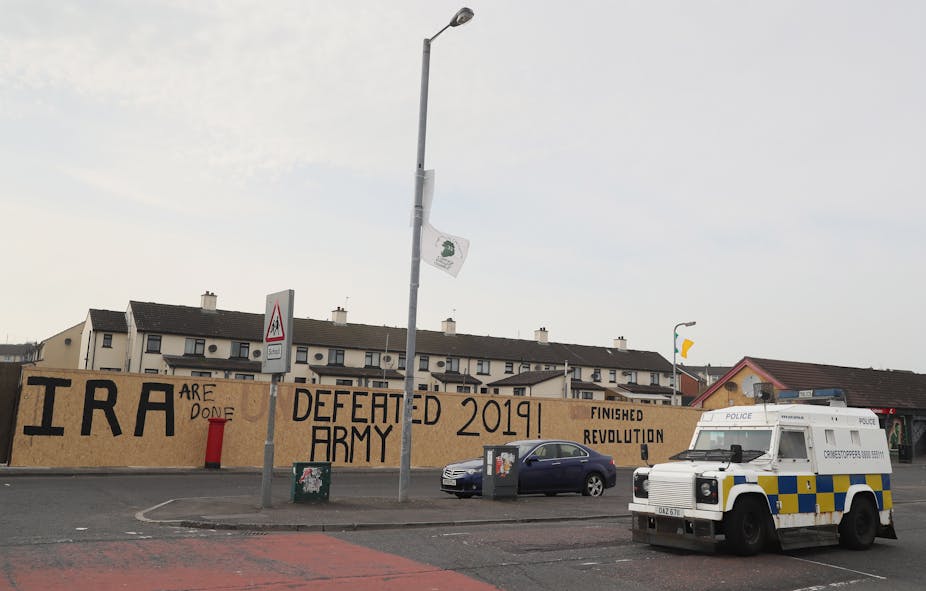The events preceding the death of journalist Lyra McKee are familiar ones for some young people growing up today in Northern Ireland. Rioting broke out as the police searched houses in Derry’s Creggan estate in the run up to Easter. Shots were then fired from the crowd, resulting in McKee’s death, which is still being investigated.
Civilians were the main casualties of Northern Ireland’s conflict and many remain scarred by its legacies – divided space, residual violence and trauma related to the conflict. Areas like Creggan are more affected than most, not only due to disproportionate experiences of violence, injury, bereavement and imprisonment, but long-term historical underinvestment, gaps in essential services and a lack of employment opportunities.
Sporadic violence, a lack of trust in the police and the continued presence of dissident paramilitaries are the everyday realities of some communities in Northern Ireland after the 1998 Belfast/Good Friday Agreement which marked the end of the period referred to as the Troubles.
Research my colleagues and I carried out in 2008 in six communities disproportionately impacted by the conflict, ten years after the Good Friday Agreement, revealed that many felt they had not benefited from the peace dividend. We reported then that violence was still part of everyday life in communities characterised by uncertainty, unease, and a lack of investment. Adults and young people alike reported that dissident paramilitary groups continued to intimidate, physically attack, shoot and exile young people for so-called “anti-community behaviour”.
Other colleagues and I heard similar accounts from youth and community workers, children and young people in research we carried out in 2016. This again revealed that as well as being the primary targets of attack and abuse, some of the so-called “agreement generation” – who grew up after 1998 – are still being drawn into violence by self-proclaimed paramilitary groups.
Routes into paramilitaries
We heard about family and community routes into involvement with dissident groups. Jess* told us she’d known about a particular paramilitary organisation since she was young, because here uncle was supposedly involved in it. She explained the intergenerational nature of some pathways:
If you’re born into an (name of paramilitary organisation) family then like there’s a good chance the boys in the family are going to be in the (organisation) as well.
Others spoke of the messages learned in communities and the historical relationship between cultural identity, masculinity and violence. Brought up in communities where masculine identity and cultural identity were closely linked, and where violence was a traditional means of expressing and exerting both, such understanding is difficult to erase in one generation. This is particularly the case when powerful adults within communities continue to politicise young men who have restricted means of attaining a sense of identity.

Power and protection
Young people recognised that those in their communities who had status, power and money were often linked to dissident groups. This could be an attraction for those living in communities with limited opportunities and some young people feared that children growing up in their community would aspire to mimic these individuals. Yet there is a complex relationship between power and protection. Being “involved” or linked to dissidents brought a “hard man” reputation affording protection from other young people.
More than this, being involved in an organisation also ensures protection from paramilitaries themselves. For those in debt to paramilitaries – fined because of alleged drug dealing, anti-social or criminal behaviour – being “in” could be their only means of protection. Maria told us:
There would be a few people that I have known that have been given the choice to either pay their debts they have to paramilitaries, or join up. And they can’t afford to pay the money, then they join up because it is either that or they are the ones getting a beating.
Search for belonging
Those we interviewed for both pieces of research noted that certain children and young people were targeted by paramilitaries to attack the police, acquire information, sell drugs or issue threats to other young people. According to Kevin and Aidan, who had both been subject to attacks from paramilitaries:
They get the young ones to go to the march (parades or commemoration events) with them and do their dirty work for them … They supply wee ones with petrol for petrol bombing cops and they supply them with paint.
Those deemed most vulnerable were those lacking resources, family support and a sense of belonging. Two young men who had been involved in dissident groups in the past spoke of the support and sense of belonging they experienced. Callum had joined “to have a family”, and Paul’s account demonstrated how he was effectively manipulated at a difficult time in his life:
I had that much going on in my head with others things … They act like your friends more, sort of reeled you in on like a fishing rod.
While not downplaying the violent actions of young people who are involved in sectarian behaviours, rioting against the police, and dissident groups, it’s crucial to recognise there are a range of complex factors involved. The so-called “agreement generation” live the past in the present – surrounded by reminders of the conflict in their communities and families, in divided space, in the daily news and in opposition politics.
Like the generation before them, some are affected more than others. While emotions are high in the wake of the shooting of Lyra McKee, this is an opportune time to harness the anger, condemnation and public momentum to ensure that the current generation of children and young people do not become another conflict generation.
* Names have been changed to protect the anonymity of the interviewees.

